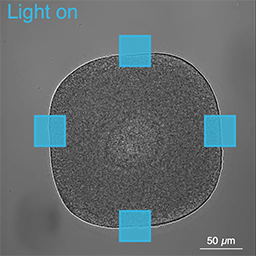Light-induced cortical excitability reveals programmable shape dynamics in starfish oocytes
Jinghui Liu, Tom Burkart, Alexander Ziepke, John Reinhard, Yu-Chen Chao, Tzer Han Tan, S. Zachary Swartz, Erwin Frey & Nikta Fakhri
 Understanding how cells generate shape changes is central to unraveling the physical basis of morphogenesis and synthetic cell design. Here, we present a quantitative theory of light-controlled cortical excitability in starfish oocytes, uncovering how programmable shape deformations arise from the interplay of biochemical signaling and mechanical response. In vivo experiments using optogenetically controlled GEFs decoupled from meiotic cues demonstrate that local or global illumination of starfish oocytes can generate a broad repertoire of mechanical behaviors—from transient pinching and surface contraction waves (SCWs) to catastrophic cell lysis. Our framework integrates these observations into a coherent chemo-mechanical model coupling nonlinear Rho dynamics to cortex elasticity, revealing the mechanisms by which optical stimuli steer intracellular contractility and cell geometry.
Understanding how cells generate shape changes is central to unraveling the physical basis of morphogenesis and synthetic cell design. Here, we present a quantitative theory of light-controlled cortical excitability in starfish oocytes, uncovering how programmable shape deformations arise from the interplay of biochemical signaling and mechanical response. In vivo experiments using optogenetically controlled GEFs decoupled from meiotic cues demonstrate that local or global illumination of starfish oocytes can generate a broad repertoire of mechanical behaviors—from transient pinching and surface contraction waves (SCWs) to catastrophic cell lysis. Our framework integrates these observations into a coherent chemo-mechanical model coupling nonlinear Rho dynamics to cortex elasticity, revealing the mechanisms by which optical stimuli steer intracellular contractility and cell geometry.
We identify two distinct excitation mechanisms—threshold and state perturbations—that underlie the diversity of shape responses. Local threshold perturbations induce pinching by transiently lowering the excitation barrier via light-triggered GEF accumulation. In contrast, sustained shape waves—either guided by large-scale anchor gradients or unguided and self-propagating—emerge from sufficiently strong state perturbations when Rho-GTP concentrations cross a critical threshold due to diffusive influx.
Numerical simulations of a reaction–diffusion model coupled to cortex mechanics reproduce the experimentally observed shape phenotypes and predict how light-induced gradients of Rho activators can steer deformation fronts. In particular, we show how spatially modulated membrane recruitment of GEFs enables guided SCWs that mimic wild-type meiotic patterns, while increasing the state susceptibility via an exogenous LARG-based GEF variant permits unguided wave propagation. A phase diagram constructed from simulations maps observed deformations—pinches, decaying waves, persistent waves, and lytic events—onto axes of threshold and state perturbation susceptibility, providing a roadmap for the rational design of shape responses. 
This work offers a unifying view of excitable cortical dynamics under optical control, demonstrating that light-induced deformation is not only programmable but also predictable through coarse-grained physical modeling. Our analysis suggests design principles for externally tunable synthetic cells and highlights the importance of nonlinear coupling in achieving robust shape transformations. More broadly, the results underscore how optogenetic control over reaction–diffusion pathways can recapitulate and extend the dynamic morphological capabilities of living cells.

